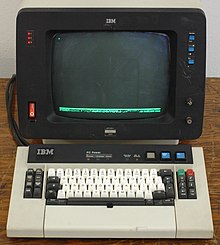IBM 3270

3270 is the name for a series of terminals from IBM . The screen terminals were presented to the public in 1971 and were available from 1972. They replaced the typewriter terminals that had been common up until then, using continuous paper as the output medium. In addition to the hardware, the number 3270 also designates the protocol that is used to transfer data on this terminal.
history
The model 3270 made it possible on a large scale online - applications to introduce. The screen could be formatted programmatically and input and output fields could be defined. After a user action, only the changed data had to be transmitted. The inputs of the users were buffered in the device or in a control unit and only transmitted to the central computer after pressing the Enter key or a function key.
The first 3270 models were monochrome and supported single or double brightness text. In addition, fields without visible text (e.g. for entering passwords) could be defined. Later, color screens (8 colors), inverse display, underlined and blinking text were also supported. The number of function keys was increased from 12 to 24 and in addition to the standard models with a resolution of 24 × 80 characters, those with 32 × 80, 43 × 80 and 27 × 132 characters were created. Special models also support vector graphics and the APL character set. Some manufacturers, for example HOB or Attachmate, built terminals compatible with the IBM 3270.
Programming 3270 applications in assembly language was very time-consuming. The Message Format Service at IMS , the Basic Mapping Support (BMS) at CICS and the panel definitions at TSO / ISPF made things easier . The Graphical Data Display Manager software offers a corresponding programming interface for creating graphics .
today
Today there are hardly any terminals in use. However, there are still some areas of application in which the terminal is preferred to a PC. Most of the 3270 applications that remain today use a terminal emulator on a PC. From IBM itself there was also the IBM 3270 PC - an ordinary IBM PC XT with hardware to emulate a 3270, including a special graphics card and a PC / 3270 keyboard. For Windows there are, for example, Hummingbird HostExplorer, IBM Personal Communications, Attachmate Extra! or Reflection, INTRA-SYS All in One 3270 or HOBLink 3270 or TerminalEdition.
The Java- based Host On-Demand (HOD) software is offered by IBM itself. It consists of a Java applet that creates a 3270 session in a web browser . In addition to screen emulation, printer emulation is also possible.
For home users who want to access a tn3270 service, for example (still common in the American library sector) or who use Hercules to emulate a mainframe computer , Vista TN3270 is an inexpensive solution. For X11 (under Unix-like operating systems) there is × 3270, which also contains various programs for scripts. zLinux supports 3270 terminals.
The transmission protocol was originally BTAM , later VTAM . Today TCP / IP is used. A special Telnet variant, tn3270 , is also used.
Web links
- Introduction to Telnet 3270. (No longer available online.) Cisco, archived from original on December 9, 2012 ; accessed on February 24, 2015 .
- RFC 1041 . - Telnet 3270 regime option . (English).
- RFC 1576 . - TN3270 Current Practices . (English).
- RFC 2355 . - TN3270 enhancements . (English).
- A brief history of 3270. (English)
Individual evidence
- ↑ IBM Archives. (English)
- ^ IBM Publication. (English)
- ↑ A brief history of 3270. ( Memento of the original from August 28, 2009 in the Internet Archive ) Info: The archive link was inserted automatically and has not yet been checked. Please check the original and archive link according to the instructions and then remove this notice. (English)